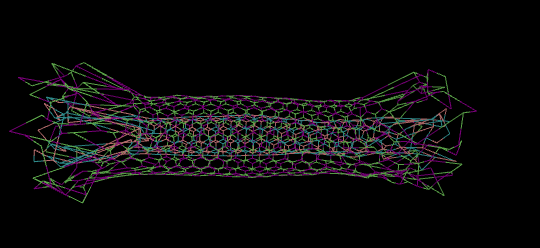Hii All,
I am simulating a concentric nanotube with length 5 nm. I want to fix the ends of the nanotube. I am doing it by using the command “fix 11 LeftEnd setforce 0.0 0.0 0.0”. However I see that the ends are deforming. When I free the ends by using “fix 11 LeftEnd setforce NULL NULL NULL”, the tube simulation is running alright but moving in the box which I do not want. The simulation box is large enough ((-150 -150 -100.626) to (150 150 100.465)) and there are periodic boundary conditions.
LAMMPS version - March 18, 2018
Thank you so much for your help. I am posting the input files and log files below.
Input File
dimension 3
units metal
atom_style full
read_data data.BNT_single
group inner type 1 2
group outer type 3 4
pair_style hybrid tersoff tersoff lj/cut 8.0
pair_coeff * * tersoff 1 BNC.tersoff B N NULL NULL
pair_coeff * * tersoff 2 BNC.tersoff NULL NULL B N
pair_coeff 1 3 lj/cut 0.004116 3.453
pair_coeff 1 4 lj/cut 0.00508 3.409
pair_coeff 2 3 lj/cut 0.00508 3.409
pair_coeff 2 4 lj/cut 0.006281 3.365
region Left block -10.0 10.00000 -10.00000 10.500000 -5.0000 1.50000
region Right block -10.0 10.00000 -10.500000 10.500000 47.0000 50.0000
group LeftEnd region Left
group RightEnd region Right
group mobile subtract all LeftEnd RightEnd
group Ends union LeftEnd RightEnd
dump 1 all custom 100 SingleBNT.lammpstrj id type x y z
dump 4 LeftEnd custom 100 LeftEnd.lammpstrj id type x y z
dump 5 RightEnd custom 100 RightEnd.lammpstrj id type x y z
thermo 100
fix 11 LeftEnd setforce 0.0 0.0 0.0
fix 22 RightEnd setforce 0.0 0.0 0.0
thermo_style custom step temp epair etotal press vol
minimize 1.0e-7 1.0e-9 100 10000
velocity all create 300.0 4928459
fix 1 all npt temp 300.0 300.0 0.1 iso 0.0 0.0 1
thermo 50
timestep 0.001
run 100000
unfix 1
Log file
LAMMPS (16 Mar 2018)
dimension 3
units metal
atom_style full
read_data data.BNT_single
orthogonal box = (-150 -150 -100.626) to (150 150 100.465)
1 by 1 by 1 MPI processor grid
reading atoms …
1200 atoms
0 = max # of 1-2 neighbors
0 = max # of 1-3 neighbors
0 = max # of 1-4 neighbors
1 = max # of special neighbors
group inner type 1 2
400 atoms in group inner
group outer type 3 4
800 atoms in group outer
pair_style hybrid tersoff tersoff lj/cut 8.0
pair_coeff * * tersoff 1 BNC.tersoff B N NULL NULL
Reading potential file BNC.tersoff with DATE: 2013-03-21
pair_coeff * * tersoff 2 BNC.tersoff NULL NULL B N
Reading potential file BNC.tersoff with DATE: 2013-03-21
pair_coeff 1 3 lj/cut 0.004116 3.453
pair_coeff 1 4 lj/cut 0.00508 3.409
pair_coeff 2 3 lj/cut 0.00508 3.409
pair_coeff 2 4 lj/cut 0.006281 3.365
region Left block -10.0 10.00000 -10.00000 10.500000 -5.0000 1.50000
region Right block -10.0 10.00000 -10.500000 10.500000 47.0000 50.0000
group LeftEnd region Left
60 atoms in group LeftEnd
group RightEnd region Right
60 atoms in group RightEnd
group mobile subtract all LeftEnd RightEnd
1080 atoms in group mobile
group Ends union LeftEnd RightEnd
120 atoms in group Ends
dump 1 all custom 100 SingleBNT.lammpstrj id type x y z
dump 4 LeftEnd custom 100 LeftEnd.lammpstrj id type x y z
dump 5 RightEnd custom 100 RightEnd.lammpstrj id type x y z
thermo 100
fix 11 LeftEnd setforce 0.0 0.0 0.0
fix 22 RightEnd setforce 0.0 0.0 0.0
thermo_style custom step temp epair etotal press vol
minimize 1.0e-7 1.0e-9 100 10000
WARNING: Using ‘neigh_modify every 1 delay 0 check yes’ setting during minimization (…/min.cpp:168)
Neighbor list info …
update every 1 steps, delay 0 steps, check yes
max neighbors/atom: 2000, page size: 100000
master list distance cutoff = 10
ghost atom cutoff = 10
binsize = 5, bins = 60 60 41
5 neighbor lists, perpetual/occasional/extra = 5 0 0
(1) pair tersoff, perpetual, skip from (4)
attributes: full, newton on
pair build: skip
stencil: none
bin: none
(2) pair tersoff, perpetual, skip from (4)
attributes: full, newton on
pair build: skip
stencil: none
bin: none
(3) pair lj/cut, perpetual, skip from (5)
attributes: half, newton on
pair build: skip
stencil: none
bin: none
(4) neighbor class addition, perpetual
attributes: full, newton on
pair build: full/bin
stencil: full/bin/3d
bin: standard
(5) neighbor class addition, perpetual, half/full from (4)
attributes: half, newton on
pair build: halffull/newton
stencil: none
bin: none
Per MPI rank memory allocation (min/avg/max) = 13.38 | 13.38 | 13.38 Mbytes
Step Temp E_pair TotEng Press Volume
0 0 -8869.6573 -8869.6573 -11.145965 18098190
13 0 -8870.0498 -8870.0498 -5.8404039 18098190
Loop time of 0.0900772 on 1 procs for 13 steps with 1200 atoms
97.7% CPU use with 1 MPI tasks x no OpenMP threads
Minimization stats:
Stopping criterion = energy tolerance
Energy initial, next-to-last, final =
-8869.65731289 -8870.04921547 -8870.04983927
Force two-norm initial, final = 5.71404 0.123522
Force max component initial, final = 0.283052 0.0098328
Final line search alpha, max atom move = 1 0.0098328
Iterations, force evaluations = 13 26
MPI task timing breakdown:
Section | min time | avg time | max time |%varavg| %total
